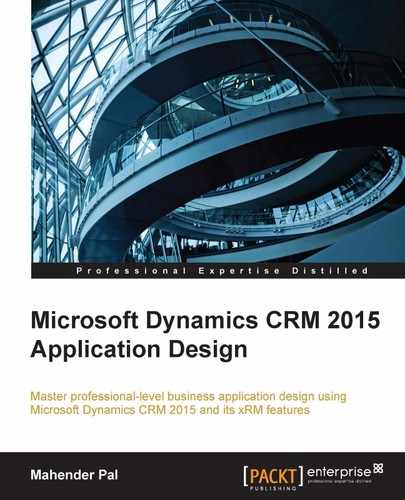Book Description
Master professional-level business application designs using Microsoft Dynamics CRM 2015 and its xRM features
About This Book
- Implement business logic using processes, plugins, and client-side scripts with MS CRM 2015
- Develop custom xRM solutions to improve your business applications
- A comprehensive guide with a solution-based approach that covers the new features of Microsoft Dynamics CRM 2015 and increasingly advanced topics
Who This Book Is For
This book targets skilled developers who are looking to build business-solution software and are new to application development in Microsoft Dynamics CRM.
What You Will Learn
- Customize your Microsoft Dynamics CRM 2015 business application with ease
- Get to know about the new features and enhancements of Microsoft Dynamics CRM 2015
- Implement process automation using workflows, business rules, and business process flows
- Carry out client-side logic and consume CRM web services using client-side code
- Work across all your iOS platforms or devices with the integration feature of SDK
- Develop and deploy plug-ins and learn how to troubleshoot issues
- Know the how-to’s of mobile enhancements with Microsoft Dynamics
In Detail
Businesses can have their developers build complete apps or plug-ins and interfaces to suit their business needs. With the application of MS CRM, administrators can alter the content, layout, and business logic for each business use case. Businesses can choose to run Dynamics CRM on their own internal server or to link to web-hosted installations. This book is an enhanced guide that covers all the new features released with Microsoft Dynamics CRM 2015. Coming straight off the shelf with a whole new frontier of updated business rules, process enhancements, SDK methods, and other enhancements, this book is a complete guide for all your Dynamics CRM questions.
Starting off, this book will introduce you to the deployment options such as online and on-premise, and the software and hardware requirements as CRM customization. It will also teach you how to develop a sample application.
Going deeper, this book teaches you about the new enhancements in Microsoft Dynamics CRM 2015 such as business process, new client-side scripting, mobile application, and actions enhancements. You will quickly get up and running with plugin development and project tracking concepts with the help of sample applications.
The book concludes with how Microsoft Dynamics CRM extends its mobile capabilities and bring more feature-rich experience to the app users.
Style and approach
A solution-based guide to learn Microsoft Dynamics CRM’s newest features, and customize and extend CRM’s capabilities. Each topic is presented with comprehensive examples for creating custom solutions.
Downloading the example code for this book. You can download the example code files for all Packt books you have purchased from your account at http://www.PacktPub.com. If you purchased this book elsewhere, you can visit http://www.PacktPub.com/support and register to have the code file.
Table of Contents
- Microsoft Dynamics CRM 2015 Application Design
- Table of Contents
- Microsoft Dynamics CRM 2015 Application Design
- Credits
- About the Author
- About the Reviewers
- www.PacktPub.com
- Preface
- 1. Getting Started with Microsoft Dynamics CRM 2015
- Deployment options
- Microsoft Dynamics CRM 2015 clients
- Software and hardware requirements
- Upgrade options
- Licensing model for Microsoft Dynamics CRM 2015
- The new features in Microsoft Dynamics CRM 2015
- Global search
- Business rules enhancement
- Business process flow
- Hierarchy visualization
- Hierarchical security
- New fields for calculation
- New capability for mobile client
- Product catalog enhancement
- Field-level security enhancement
- Creating custom help
- Disabling the welcome screen
- Nested quick create forms
- New outlook configuration wizard
- Service Level Agreement enhancement
- Synchronization between CRM and Outlook or Exchange
- Summary
- 2. Customizing Microsoft Dynamics CRM 2015
- Training solution scope
- Training solution design
- Understanding the customization concept
- Customizing Microsoft Dynamics CRM 2015
- Understanding application navigation
- Understanding solutions
- Creating the publisher
- Creating our solution
- Adding components to our solution
- Customizing entities
- Data types in Microsoft Dynamics CRM 2015
- Field properties
- Setting data structures for a training solution
- Customizing entity forms
- Customizing application navigation
- Setting up a training catalog
- Understanding security
- Testing customization
- Summary
- 3. Client-side Logic with Microsoft Dynamics CRM 2015
- 4. Working with Processes
- Understanding processes
- Building a library management solution
- Understanding business process flow
- Understanding workflows
- Creating asynchronous workflows
- Creating synchronous workflows
- Understanding dialogs
- Understanding actions
- Business process flows versus workflows, dialogs, and actions
- Testing library management
- Summary
- 5. Working with CRM SDK
- Understanding CRM extendibility architecture
- An introduction to the Microsoft Dynamics CRM SDK
- Knowing about CRM assemblies
- Understanding CRM web services
- Using client APIs for CRM connections
- Working with organization web services
- Working with discovery web service
- Fetching data from the CRM database
- Top five new features in 2015 Update 1 for developers
- Integrating CRM with other systems
- Summary
- 6. Extending Microsoft Dynamics CRM 2015
- Introduction to plug-ins
- Synchronous versus a synchronous plug-ins
- Understanding plug-in event execution pipelines
- Writing your first sample plug-in
- Understanding plug-in registration
- Understanding IPluginExecutionContext
- Applying validation using plug-ins
- Passing parameters to plug-ins
- Troubleshooting plug-ins
- Working with custom workflows
- Understanding actions
- Summary
- 7. Creating a Project Tracking Application
- 8. Introduction to Mobile Client and Microsoft Dynamics Marketing
- Introduction to Microsoft Dynamics CRM mobility
- Accessing CRM using mobiles
- Accessing CRM on tablets
- Entities available over mobiles
- Customizing mobile clients
- New enhancements for MOCA
- Other mobile clients
- Introduction to MDM
- Setting up the Microsoft Dynamics Marketing trial
- Integration with CRM
- Summary
- A. Data Model for Client Entities
- B. Data Model for Account Entities
- Index
